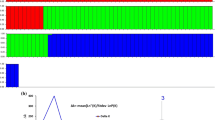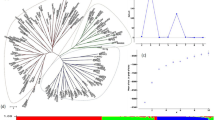Abstract
A core collection reflects the diversity of the larger germplasm collection and makes the evaluation of genetic resources more effective. To improve barley germplasm management, we propose the construction of a core genetic collection derived from a set of 204 six-rowed hulless barley accessions (39 registered cultivars and 165 landraces) native to the Qinghai-Tibetan Plateau (QTP). A sampling percentage of 20% was predicted by the maximization strategy. Five different sampling strategies (Mstrat, Random, REMC, SBS, and SFS) were applied to establish 5 primary core collections from the original 204 accessions using 1750 single-nucleotide polymorphism (SNP) markers. After the evaluation and analysis of core collection representativeness, the Mstrat strategy was determined to be a valid method for developing a core collection. A total of 41 barley accessions were obtained, including 11 registered cultivars and 30 landraces. Genetic structure analysis of the 204 barley accessions showed that the core collection was evenly distributed throughout the initial collection, indicating that the core collection represented the larger germplasm well. A subset of 28 SNP markers were produced and used to distinguish all 204 barley accessions from each other. We believe the collection of 28 SNP markers will be incredibly helpful to barley breeders. Furthermore, the core collection ensures the long-term conservation of genetic resources and will support improvements to six-rowed hulless barley from the Qinghai-Tibetan Plateau.




Similar content being viewed by others
References
Agrama HA, Yan WG, Lee F, Fjellstrom R, Chen MH, Jia M, McClung A (2009) Genetic assessment of a mini-core subset developed from the USDA rice genebank. Crop Sci 49:1336–1346
Alexander DH, Novembre J, Lange K (2009) Fast model-based estimation of ancestry in unrelated individuals. Genome Res 19:1655–1664
Arber W, Illmensee K, Peacock WJ, Starlinger P (1984) Genetic manipulation: impact on man and society (no. 1). Cambridge University press
Badr A, Sch R, Rabey HE, Effgen S, Ibrahim HH, Pozzi C, Rohde W, Salamini F (2000) On the origin and domestication history of barley (Hordeum vulgare). Mol Biol Evol 17:499–510
Bataillon TM, David JL, Schoen DJ (1996) Neutral genetic markers and conservation genetics: simulated germplasm collections. Genetics 144:409–417
Belaj A, del Carmen D-GM, Atienza SG, Urdíroz NM, De la Rosa R, Satovic Z, Martin A, Kilian A, Trujillo I, Valpuesta V, Del Río C (2012) Developing a core collection of olive ( Olea europaea L.) based on molecular markers (DArTs, SSRs, SNPs) and agronomic traits. Tree Genet Genomes 8:365–378
Brown AHD (1989) Core collections: a practical approach to genetic resources management. Genome 31:818–824
De Beukelaer H, Smýkal P, Davenport GF, Fack V (2012) Core hunter II: fast core subset selection based on multiple genetic diversity measures using mixed replica search. BMC Bioinformatics 13:312–312
Díez CM, Imperato A, Rallo L, Barranco D, Trujillo I (2012) Worldwide core collection of olive cultivars based on simple sequence repeat and morphological markers. Crop Sci 52:211–221
Doyle JJ (1990) Isolation of plant DNA from fresh tissue. Focus 12:39–40
Excoffier L, Lischer HE (2010) Arlequin suite ver 3.5: a new series of programs to perform population genetics analyses under Linux and windows. Mol Ecol Resour10:564–567
Franco J, Crossa J, Warburton ML, Taba S (2006) Sampling strategies for conserving maize diversity when forming core subsets using genetic markers. Crop Sci 46:854–864
Fu DX (2001) The discovery, identification and research on archaeobotanical remains from the neolithic site of Changguogou. Kaogu:66–74
Garcia-Lor A, Luro F, Ollitrault P, Navarro L (2017) Comparative analysis of core collection sampling methods for mandarin germplasm based on molecular and phenotypic data. Ann Appl Biol 171:327–339
Gouesnard B, Bataillon TM, Decoux G, Rozale C, Schoen DJ, David JL (2001) MSTRAT: an algorithm for building germ plasm core collections by maximizing allelic or phenotypic richness. J Hered 92:93–94
Hu J, Zhu J, Xu HM (2000) Methods of constructing core collections by stepwise clustering with three sampling strategies based on the genotypic values of crops. Theor Appl Genet 101:264–268
Igartua E, Gracia MP, Lasa JM, Medina B, Molinacano JL, Montoya JL, Romagosa I (1998) The Spanish barley core collection. Genet Resour Crop Evol 45:475–481
Li H, Handsaker B, Wysoker A, Fennell T, Ruan J, Homer N, Marth G, Abecasis G, Durbin R (2009) The sequence alignment/map format and SAMtools. Bioinformatics 25:2078–2079
Liu H, Yu L (2005) Toward integrating feature selection algorithms for classification and clustering. IEEE T Knowl Data En 17:491–502
Marita JM, Rodriguez JM, Nienhuis J (2000) Development of an algorithm identifying maximally diverse core collections. Genet Resour Crop Evol 47:515–526
Mascher M, Gundlach H, Himmelbach A, Beier S, Twardziok SO, Wicker T, Radchuk V, Dockter CE, Hedley P, Russell J et al (2017) A chromosome conformation capture ordered sequence of the barley genome. Nature 544:427–433
McKenna A, Hanna M, Banks E, Sivachenko A, Cibulskis K, Kernytsky A, Garimella K, Altshuler D, Gabriel S, Daly M, Depristo MA (2010) The genome analysis toolkit: a MapReduce framework for analyzing next-generation DNA sequencing data. Genome Res 20:1297–1303
Peakall ROD, Smouse PE (2012) GenAlEx 6.5: genetic analysis in excel. Population genetic software for teaching and research. Mol Ecol 6:288–295
Purcell S, Neale B, Todd-Brown K, Thomas L, Ferreira MAR, Bender D, Maller J, Sklar P, de Bakker PIW, Daly MJ, Sham PC (2007) PLINK: a tool set for whole-genome association and population-based linkage analyses. Am J Hum Genet 81:559–575
Schoen DJ, Brown AH (1993) Conservation of allelic richness in wild crop relatives is aided by assessment of genetic markers. P Natl Acad Sci USA 90:10623–10627
Tamura K, Stecher G, Peterson D, Filipski A, Kumar S (2013) MEGA6: molecular evolutionary genetics analysis version 6.0. Mol Biol Evol 30:2725–2729
Thachuk C, Crossa J, Franco J, Dreisigacker S, Warburton M, Davenport GF (2009) Core hunter: an algorithm for sampling genetic resources based on multiple genetic measures. BMC Bioinform 10:243
Upadhyaya HD, Sharma S, Gowda CLL, Reddy VG, Singh S (2011) Developing proso millet (Panicum miliaceum L.) core collection using geographic and morpho-agronomic data. Crop Pasture Sci 62:383–389
Van Hintum TJ (1994) Comparison of marker systems and construction of a core collection in a pedigree of European spring barley. Theor Appl Genet 89:991–997
Van Hintum TJ, Von Bothmer R, Visser DL (1995) Sampling strategies for composing a core collection of cultivated barley (Hordeum vulgare s.lat.) collected in China. Hereditas 122:7–17
Van Treuren R, Tchoudinova I, Van Soest LJM, Van Hintum TJ (2006) Marker-assisted acquisition and core collection formation: a case study in barley using AFLPs and pedigree data. Genet Resour Crop Evol 53:43–52
Wang L, Xu J, Xia T, Zhang H, Liu D, Shen Y (2014) Population structure and linkage disequilibrium in six-rowed barley landraces from the Qinghai-Tibetan Plateau. Crop Sci 54:2011–2022
Xu TW (1975) On the origin and phylogeny of cultivated barley with reference to the discovery of Ganze wild two-rowed barley Hordeum spontaneum C.Koch. Acta Genet Sin 2:129–137
Xu H, Mei Y, Hu J, Zhu J, Gong P (2006) Sampling a core collection of island cotton ( Gossypium barbadense L.) based on the genotypic values of fiber traits. Genet Resour Crop Evol 53:515–521
Yang J, Lee SH, Goddard ME, Visscher PM (2011) GCTA: a tool for genome-wide complex trait analysis. Am J Hum Genet 88:76–82
Yuan HZ, Zeng XQ, Xu QJ, Wang YL, Zha S, Nyima T (2018) Genetic diversity of germplasm resource and core collection development in hulless barley. J Triticeae Crops 38:922–928
Zaharieva M, Monneveux P, Henry M, Rivoal R, Valkoun J, Nachit MM (2001) Evaluation of a collection of wild wheat relative Aegilops geniculata Roth and identification of potential sources for useful traits. Euphytica 119:33–38
Zhang J, Wang Y, Zhang XZ, Li TZ, Wang K, Xu XF, Han ZH (2010) Sampling strategy to develop a primary core collection of apple cultivars based on fruit traits. Afr J Biotechnol 9:123–127
Funding
This research was financially supported by the Second Tibetan Plateau Scientific Expedition and Research (STEP) program (Grant No. 2019QZKK0303), Construction Project for Innovation Platform of Qinghai province (2017-ZJ-Y14), Science and Technology Service Network Initiative (STS) of CAS, and Innovation Academy for Seed Design, CAS.
Author information
Authors and Affiliations
Corresponding author
Ethics declarations
Conflict of Interest
The authors declare that they have no conflict of interest.
Additional information
Publisher’s Note
Springer Nature remains neutral with regard to jurisdictional claims in published maps and institutional affiliations.
Key Message
A core collection of six-rowed naked hulless barley from the Qinghai-Tibetan Plateau (QTP), including 41 barley accessions, was established. A subset of 28 SNP markers were produced and used to distinguish all 204 barley accessions from each other.
Rights and permissions
About this article
Cite this article
Xu, J., Wang, L., Wang, H. et al. Development of a Core Collection of Six-Rowed Hulless Barley from the Qinghai-Tibetan Plateau. Plant Mol Biol Rep 38, 305–313 (2020). https://doi.org/10.1007/s11105-020-01196-0
Published:
Issue Date:
DOI: https://doi.org/10.1007/s11105-020-01196-0




